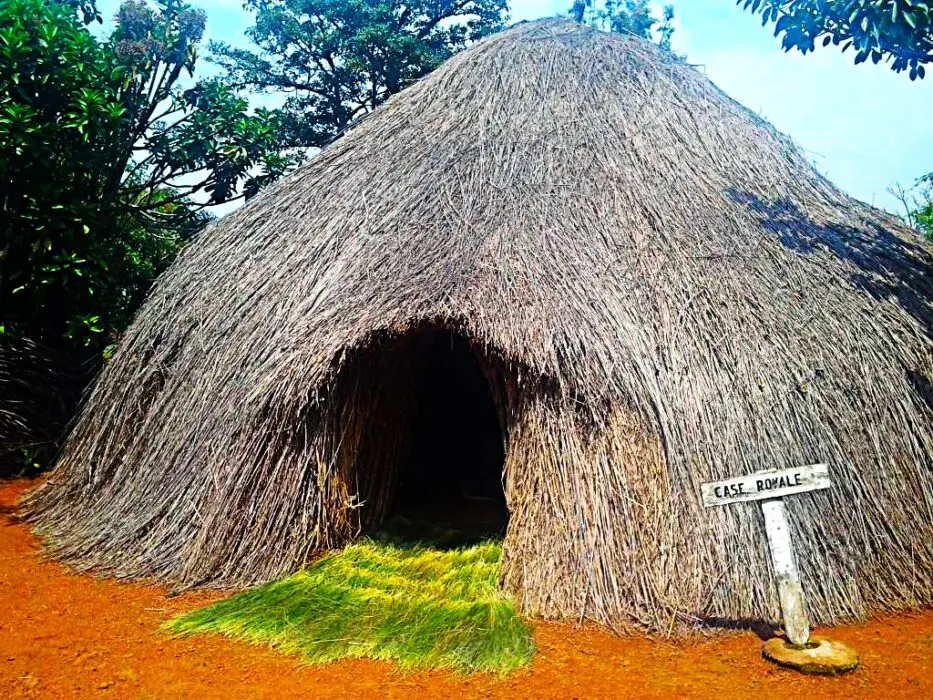The Royal Palace of Gishora, located in the province of Gitega in Burundi, is one of the country's most emblematic historical and cultural sites. The palace plays a crucial role in preserving Burundi's history and traditions. It is particularly well known as the home of the famous sacred drums, an essential element of Burundian cultural identity.
History of the Royal Palace of Gishora
The Royal Palace of Gishora was founded in the 19th century by King Mwezi Gisabo, who ruled Burundi during a tumultuous period marked by conflicts with German colonists. Mwezi Gisabo used Gishora as a strategic center for both political and cultural reasons. The site was chosen because of its geographical position, on a hill offering an unobstructed view of the surrounding region, making it defensible against attack.
The palace itself is made up of several traditional huts, built according to local architecture, using materials such as wood and straw. The whole site is a living example of traditional Burundian architecture and building techniques, which have evolved little over the centuries.
The Royal Drums of Gishora
One of the most remarkable aspects of the Gishora Royal Palace is the presence of the royal drums, or "Ingoma", which are not only musical instruments but also sacred objects. These drums were once used for important ceremonies such as coronations, royal weddings and funerals. They symbolize the unity and continuity of the kingdom, and their sound echoes the history of Burundi.
Royal drums are not played by just anyone. There is a specific tradition that dictates who can play these drums and under what circumstances. This tradition is strictly adhered to, and adds to the mystical aura that surrounds the Royal Palace of Gishora. The presence of these drums makes Gishora a must-see for anyone interested in the history and culture of Burundi.
Prices, Opening Hours and Practical Information
The Gishora Royal Palace is open to the public every day of the week, generally from 9:00 am to 5:00 pm. Entrance fees for visitors are known on the spot, as prices and fees have not yet been formalized.
The site is accessible by road from the town of Gitega, some 7 kilometers from the palace. Visitors can reach Gishora by car or motorcycle cab, a common means of transport in the region. For those who prefer public transport, minibuses run regularly between Gitega and the Gishora area.
It is important to note that certain restrictions apply when visiting the Royal Palace of Gishora. For example, photography may be restricted in certain areas of the site, particularly around the royal drums, out of respect for their sacred nature. It is also advisable to arrange a guided tour in advance, to better understand the cultural and historical significance of the site.
Gishora Palace today
Today, the Royal Palace of Gishora is a tourist and cultural site. It regularly hosts traditional ceremonies, festivals and cultural events, enabling visitors to discover Burundian traditions and customs at first hand.
However, the palace has not been entirely preserved in its original state. Restoration efforts have been undertaken over the years to maintain the site, but these efforts are often limited by insufficient financial resources. As a result, some parts of the palace are showing signs of wear and deterioration, which could affect the long-term integrity of the site.
Advantages and disadvantages of the Gishora Royal Palace
The Royal Palace of Gishora offers a number of advantages, not least its historical and cultural significance. For researchers and history buffs, it offers a unique opportunity to delve into Burundi's pre-colonial history. The presence of the royal drums, in particular, is a major asset that attracts visitors from all over the world.
What's more, the site is accessible from Gitega, Burundi's political capital, making it a relatively easy excursion for tourists. Guided tours enable visitors to better understand the significance of the palace and the traditions that surround it.
However, the Royal Palace of Gishora also has its drawbacks. The lack of resources for proper conservation is a major problem. Without appropriate intervention, there is a risk that this historic site will be irreparably damaged. In addition, the lack of modern tourist facilities in the area, such as quality accommodation and catering services, may discourage some potential visitors.
Another drawback is that, although the palace is an important cultural symbol, it is not always easy for international visitors to fully understand its significance without a prior in-depth knowledge of Burundian history. The information available on site is sometimes limited, and the language barrier can also pose a challenge.
Conclusion
The Royal Palace of Gishora is a site of great historical and cultural importance for Burundi. It plays a crucial role in preserving the country's traditions and history. The royal drums preserved there are particularly remarkable and represent an integral part of Burundian identity. However, to ensure the preservation of this site for future generations, further efforts in terms of conservation and infrastructure are required.


No Title
The Best Photography Awards team expresses a special compliment for your photography and would like to invite you to take part in the new season of the competition.
BPA awards - international photography competition for professionals and amateurs.
There are 17 different categories available in the competition.
On the official website you can also find information about prizes, jury members, list of categories and basic conditions.
Official website: www.bestphotographyawards.com
The final submission of applications for the competition is currently underway.
April 30, 2025 is the final deadline.
We will be glad to see you among the participants and wish you a wonderful week!
Write to us if you have any questions.
Best regards
BPA Team